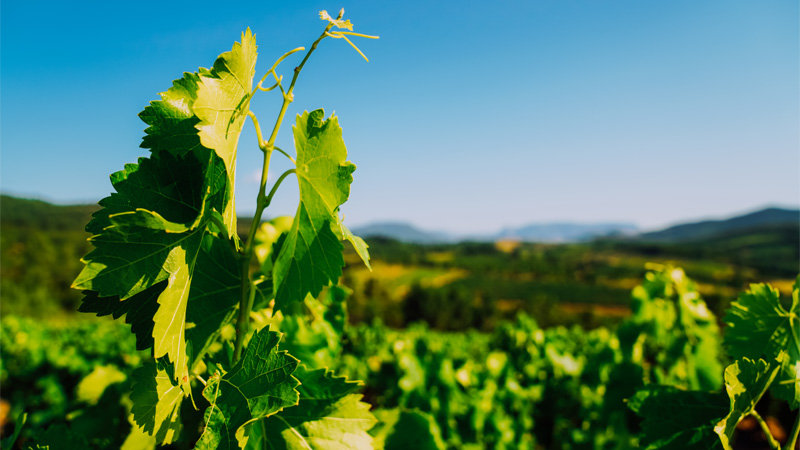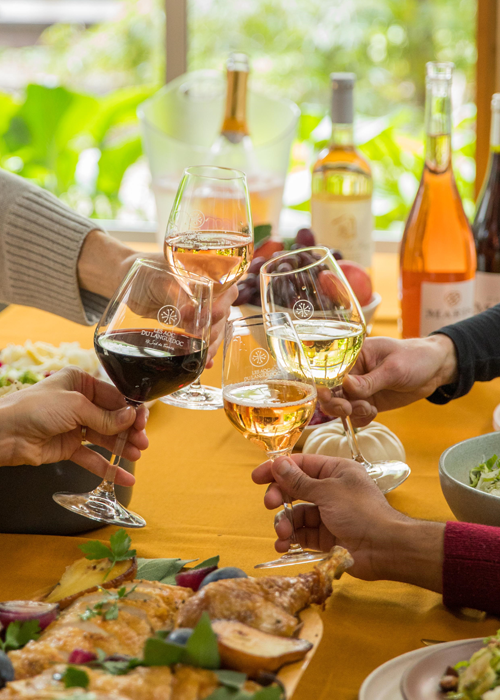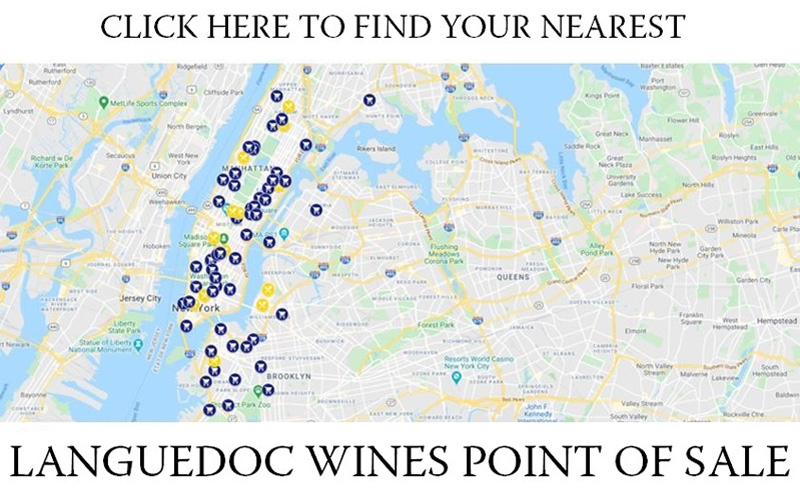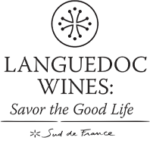
Languedoc, in the south of France, is the type of wine country that’s an obvious sell, the perfect backdrop to play with your senses. The landscape a pastoral mix of the rolling foothills of the Pyrenees Mountains and sunshine reflecting off the Mediterranean Sea, and the wines bring to mind crisp breeze, rustic food, and great conversation among friends.
Languedoc is France’s largest vineyard area, representing 30 percent of all French wine production and a rich diversity of wine profiles. It’s a region that focuses immensely on the environment, with locals working to protect their postcard-like quality by staying exceedingly natural when it comes to agriculture. The winemakers are increasingly employing natural, organic, and biodynamic practices in their vineyards and cellars, a means of preserving the inherent beauty of the place and with the belief that the quality of the wines is better because of it. Languedoc is the largest organic winemaking region in France, containing 34 percent of France’s organic vineyards. The region also makes up 10 percent of the world’s organic vineyards!
“The wines of Languedoc are amazing on so many levels,” says Mia Van de Water, a Master Sommelier and assistant general manager at Cote Korean Steakhouse in New York. “The combination of intense, juicy fruit from the warm climate of Languedoc coupled with a strong non-interventionist, natural movement produces wines that are charming, ebullient, and universally appealing.”
This — along with their outstanding value — is what has in-the-know sommeliers from New York to San Francisco clambering for red, rosé, white, and sparkling wines from Languedoc’s innovative producers and highly regarded appellations.
The history of the very large region of Languedoc is apparent in every corner, including the Roman ruins that still dot its hills. Home to France’s oldest vineyards, which date back to the 5th century B.C.E., Languedoc made sparkling wine long before Champagne, and it’s one the last regions where nearly 100 different varieties of grapes are still grown, including several indigenous to the region. Sommeliers like Van de Water love the vast spectrum of crisp whites, easy-drinking blends, and age-worthy reds because there’s always something, no matter what a guest is in the mood to drink.
Plus, the price of entry for Languedoc wines makes them accessible for all wine drinkers, offering value even when it comes to iconic splurge wines.
With all this praise for the wines, VinePair wanted to get into the heads of Languedoc-loving sommeliers to fully understand just what is so alluring about the wines from this region. Here’s what they had to say:
New World, Meet Old World
“I often use Languedoc wines as a way to get customers who traditionally only drink New World wines from California and Argentina into drinking French wines,” says sommelier Derrick C. Westbrook, who runs the wine program at 1340 BWS in Chicago.
Westbrook says he’s found that many of Languedoc’s reds have “a richness and a touch of ripeness with softer tannins and good weight” that make them particularly appealing to drinkers who have an affinity for bigger-bodied red wines. He often recommends the Cinsault-based Clos Centeilles, Campagne de Centeilles, AOC Minervois, Red, 2003 available in Chicago at 1340 Beer Wine and Spirits ($28), for its the Pinot Noir-like qualities that always seem to be crowd-pleasing.
For those same New World drinkers, he appreciates that Languedoc spells out grape varieties on the labels — as opposed to only including regional names like many other French wines. “It makes it easier for [American] wine drinkers of all levels,” says Westbrook. Case in point: The Chateau La Roque, AOC Pic Saint Loup, Red, 2017, available at Binny’s ($18), which denotes right on the front label it’s a Mourvèdre-based blend.
Endless Pairing Potential
With so many grapes and so many styles of wines, Languedoc always has an answer to the question of what to pair with food. For Cote in New York, Van de Water has found just as many wines from Languedoc to go with the restaurant’s broad spectrum of Korean flavors — from fermented to spicy to charred — as she has for the old-school French cooking she does at home.
“I really love the racy acidity of the wines with all of the pickles, kimchis, and other savory accompaniments we bring to the table [at Cote],” she says. “For guests who prefer a more structured wine with their steaks, higher-elevation plantings in Languedoc result in intense, powerhouse wines; they’re the perfect choice.” She is also a huge fan of red meat with the dark-fruited Mas de Daumas Gassac IGP St Guilhem-le-Désert Cité d’Aniane, Red, 2016, available at Astor Wines ($44), which she calls one of the finest French Cabernet Sauvignons.
As a self-proclaimed lover of French country cuisine, Van de Water often makes rustic cassoulet, her favorite dish, at home. With this, she likes to drink “the ripely generous wines of Languedoc” like Domaine Leon Barral, Tradition, AOC Faugères, Red, 2016, available at Leon & Son ($38), a red blend of Carignan, Cinsault, and Grenache.
Wines for Chilling
When asked what she likes to eat with wines from Languedoc, Angel Davis of Fig & Thistle in San Francisco jokes that she hasn’t done much pairing. “I start drinking a glass and then the whole bottle is gone,” she says with a laugh. But truthfully, she says the wines generally have qualities that make them ideal for aperitif sippers or a casual post-work glass, with or without food. She often grabs “fun and easy-to-drink” rosés or puts a chill on light reds.
Languedoc actually produces the most rosé in France, accounting for 30 percent of the total market and 8 percent worldwide. Currently, winemakers in the region are working on developing age-worthy rosés, creating a premium product for the category. They know a thing or two about balanced, fruit-forward pink wines that don’t demand a massive meal to be enjoyed. One such bottling is Les Vignerons de Fontes “Prieuré Saint-Hippolyte” AOC Languedoc, Rosé, 2019, available at K&L Wine Merchants ($12). A light red perfect to enjoy slightly chilled is the Col des Vents by Castelmaure, Cuvee Speciale, AOC Corbieres, Red, 2018, available at The San Francisco Wine Trading Company ($14).
Organics Frontrunner
The region “is rocking the most organic wines in France,” says Omar Lima, sommelier at the Maybourne Beverly Hills Hotel in Los Angeles, noting that many a “wine nerd” has also fallen for the low-intervention winemaking techniques in the region. He explains that, as a whole, Languedoc has been on a mission to convert its vineyard practices to organic or biodynamic farming, with a strong emphasis on sustainability for the next generation. In fact, Languedoc is home to 33 percent of France’s organic vineyards, more than any other region.
Producers new and old are opting for a variety of certifications to show consumers that they have put in the effort, which includes compensating workers fairly. When asked what Languedoc wines he recommends, it just so happens that they are both certified biodynamic: Domaine de Fontsainte, Gris de Gris, AOC Corbières, Rosé, 2019, available at Kermit Lynch Wine Merchant ($18), a juicy, minerally rosé from Corbières, and Gérard Bertrand, L’Hospitalet Grand Vin, AOC La Clape, Red, 2017, available at Wine.com ($40), a classic southern French red blend of Syrah, Grenache, and Mourvèdre.
Attention-Getting Bubbles
Janeen Jason’s first Languedoc love was sparkling wine from Limoux. The certified sommelier and wine buyer for VinoTeca, a wine shop in Atlanta, was taken by the wine’s character — it was unlike any other sparkling she had had. Limoux is the birthplace of sparkling wine, with the style originating in Languedoc long before Champagne. Languedoc sparklers are made using the méthode traditionnelle. The terroir and varieties (such as Chenin Blanc and Mauzac) offer mineral-driven flavors, creamy textures, and tart fruit notes that work with a variety of foods beyond your typical sparkling-wine pairings: for example, Girl Scout shortbread cookies (Jason tried it).
“It’s amazing when a wine changes your perception of the food you’re having,” she says of the wine bringing complexity to the simple buttery wafers.
Jason often reaches for the Maison Antech-Limoux & JP Bourgeois, Clara Vie Brut Nature, AOC Blanquette de Limoux, White, NV, available at her shop VinoTeca ($22), a no-dosage sparkling wine made predominantly from Mauzac, and regularly recommends the citrusy, brioche-y Domaine J. Laurens, Le Moulin Brut, AOC Blanquette de Limoux, White, NV, available at her shop but also at Perrine’s Wine Shop ($19) in Atlanta.
Not located in any of these five regions? Check out our picks below for Houston, D.C., and Miami.
Houston
- Ermitage du Pic St-Loup, AOC Pic St-Loup, Rosé, 2019, available at Houston Wine Merchant ($24)
- Clos Fantine, Cuvée Courtiol, AOC Faugères, Red, 2017, available at Light Years Wine ($36)
Washington, D.C.
- Le Clos des Jarres, Insouciance, IGP Coteaux de Peyriac, Red, 2018, available at Domestique Wine ($18)
- HB, Cave des Costières de Pomerols, AOP Picpoul de Pinet, White, 2019, available at Addy Bassin’s Mac Arthur Beverages ($8)
Miami
- Château de Paraza, Cuvee Speciale, AOC Minervois, Red, 2016, available at 305 Wines ($14,99)
- Château Les Bugadelles, Bergerie, AOC Languedoc, White, 2018, available at Mr. D Wine Merchant ($19)
For more retailers and restaurants where you can get your favorite Languedoc wine, check out our map here!
This article is sponsored by Languedoc Wines.




